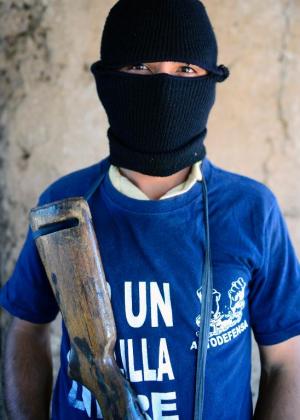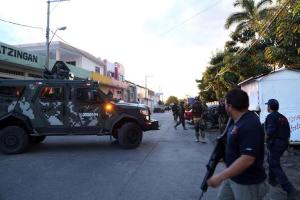Mexico City (AFP) - Mexico's government has taken down almost
the entire leadership of one of the country's most vicious drug
cartels, but it can barely savor victory amid rising violence around the
capital.
With the killing of Knights Templar gang leader
Enrique "Kike" Plancarte on Monday, authorities have now captured or
gunned down all but one of the chiefs of a gang that has tormented the
western state of Michoacan.
But success against the Knights Templar may have come with a price, with security experts saying that Mexico City's suburbs could be affected by the "cucaracha" effect.
The theory goes that the dismantling of a criminal group causes gangsters to flee like cockroaches to neighboring regions, in this case the State of Mexico that wraps around most of the capital.
Plancarte, for instance, was killed by marines who tracked him down in the neighboring central state of Queretaro, which is not known for drug violence.
- 'Great success' -
The government has deployed 10,000 troops and federal police to Michoacan, where civilians formed vigilante forces a year ago to combat the Knights Templar.
Plancarte's death came three weeks after Knights Templar founder Nazario Moreno, alias "El Chayo," was killed by troops in Michoacan on March 9.
With the capture of Plancarte's uncle in January, Servando "La Tuta" Gomez has been left as the sole remaining top leader of the cartel.
"It is a great success for the government because it is taking out the head of the criminal structure," Raul Benitez Manaut, a security expert at Mexico's National Autonomous University, told AFP.
Jaime Rivera, crime analyst at Michoacana University, said the government "could be close to a virtual dismantling of the Knights Templar organization."
The cartel may not completely disappear but "change its size and its capacity to impose its will on local and state authorities," Rivera said.
Like other cartels whose leaders have been killed or captured in the past, the Knights Templar may break up into small criminal gangs while others may spark a turf war for control of Michoacan's drug trade, he said.
President Enrique Pena Nieto's administration has delivered important blows to other major cartels.
Mexican marines captured the country's most wanted drug kingpin, Sinaloa cartel leader Joaquin "El Chapo" Guzman, in his northwestern home state on February 22.
- Violence around capital -
Pena Nieto's government cites official figures showing a decline in homicides in the past year, but extortion rackets and kidnappings have shot up.
Officials say the success authorities have had in breaking down cartels have caused gang members to branch out to other activities.
The number of murders has surged this year in the State of Mexico, the country's most populous federal entity with 15 million people.
But success against the Knights Templar may have come with a price, with security experts saying that Mexico City's suburbs could be affected by the "cucaracha" effect.
The theory goes that the dismantling of a criminal group causes gangsters to flee like cockroaches to neighboring regions, in this case the State of Mexico that wraps around most of the capital.
Plancarte, for instance, was killed by marines who tracked him down in the neighboring central state of Queretaro, which is not known for drug violence.
- 'Great success' -
The government has deployed 10,000 troops and federal police to Michoacan, where civilians formed vigilante forces a year ago to combat the Knights Templar.
Plancarte's death came three weeks after Knights Templar founder Nazario Moreno, alias "El Chayo," was killed by troops in Michoacan on March 9.
With the capture of Plancarte's uncle in January, Servando "La Tuta" Gomez has been left as the sole remaining top leader of the cartel.
"It is a great success for the government because it is taking out the head of the criminal structure," Raul Benitez Manaut, a security expert at Mexico's National Autonomous University, told AFP.
Jaime Rivera, crime analyst at Michoacana University, said the government "could be close to a virtual dismantling of the Knights Templar organization."
The cartel may not completely disappear but "change its size and its capacity to impose its will on local and state authorities," Rivera said.
Like other cartels whose leaders have been killed or captured in the past, the Knights Templar may break up into small criminal gangs while others may spark a turf war for control of Michoacan's drug trade, he said.
President Enrique Pena Nieto's administration has delivered important blows to other major cartels.
Mexican marines captured the country's most wanted drug kingpin, Sinaloa cartel leader Joaquin "El Chapo" Guzman, in his northwestern home state on February 22.
The authorities
have also arrested or killed several top leaders of the Gulf and Zetas
drug cartels, which have battled for control of drug routes in the
northeast.
Mexico's drug cartels have engaged in bloody turf wars that
have left some 80,000 people dead since 2006, when Pena Nieto's
predecessor deployed the military against the gangs.- Violence around capital -
Pena Nieto's government cites official figures showing a decline in homicides in the past year, but extortion rackets and kidnappings have shot up.
Officials say the success authorities have had in breaking down cartels have caused gang members to branch out to other activities.
The number of murders has surged this year in the State of Mexico, the country's most populous federal entity with 15 million people.
Kidnappings
have also surged in the state of Morelos, just south of Mexico City,
prompting Governor Graco Ramirez to publicly apologize to victims.
"In
the case of Mexico State a 'cucaracha effect' has taken place," Benitez
Manaut said, adding that Knights Templar members have moved in.
The state has seen 374 murders in the first two months of the year compared to 303 in the same period in 2013.
Interior
Minister Miguel Angel Osorio Chong announced Monday a new security
strategy for Mexico State that includes increasing the number of federal
security forces and firing corrupt local police officers.








No comments:
Post a Comment